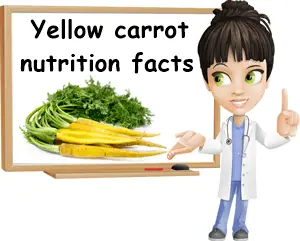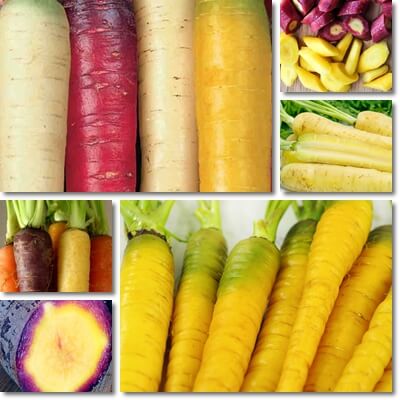Yellow carrots are the same vegetable as the more common orange carrots, just a different color. The nutrition of yellow carrots is similar to that of other carrot colors, with the exception of a low vitamin A content. Y
ellow carrots are natural sources of lutein and zeaxanthin, two yellow pigmented carotenoid antioxidants that promote the physical health of the eyes and reduce risks of age-related macular degeneration and cataract. The nutritional value of yellow carrots is boosted if you eat the carrots with a source of fat to help absorb as much of the yellow antioxidants as possible.
Why are some carrots yellow?
What makes some carrots yellow instead of orange, purple, blue, red or black is a high content of organic yellow pigments called xanthophylls. More exactly, yellow carrots owe their color to the xanthophylls lutein and zeaxanthin. By comparison, orange carrots owe their color to carotenes such as beta-carotene, alpha-carotene and beta-cryptoxanthin, while red carrots owe their color to the carotene lycopene. Purple carrots, blue carrots and black carrots owe their color to pigments called anthocyanins.
Find out more about yellow carrots.

Yellow carrot nutrition facts per 100 grams
- Energetic value: 41 kilocalories/kcal/calories
- Carbohydrates content: 9.6 grams
- Fiber content: 2.8 grams
- Sugar: 4.7 grams
- Protein content: 0.9 grams
- Fat content: 0.25 grams
- Water content: 88.3 grams
Vitamins in yellow carrots:
- Vitamin A: low content (currently undetermined)
- Vitamin B1: 0.066 mg (milligrams)
- Vitamin B2: 0.058 mg
- Vitamin B3: 0.98 mg
- Vitamin B5: 0.273 mg
- Vitamin B6: 0.138 mg
- Vitamin B9: 19 mcg (micrograms)
- Vitamin B12: 0 mcg
- Choline: 8.8 mg
- Vitamin C: 5.9 mg
- Vitamin D: 0 mcg
- Vitamin E: 0.66 mg
- Vitamin K: 13 mcg
Minerals in yellow carrots:
- Calcium: 33 mg
- Copper: 0.045 mg
- Iron: 0.3 mg
- Magnesium: 12 mg
- Manganese: 0.143 mg
- Phosphorus: 35 mg
- Potassium: 320 mg
- Selenium: 0.1 mcg
- Sodium: 69 mg
- Zinc: 0.24 mg
Note: The following nutrition facts for yellow carrots are inferred from available information on the nutritional value of orange carrots and will be updated as new information comes in.

Yellow carrots nutritional value
Yellow carrots have pretty much the same nutritional value as other carrot colors, with the exception of their vitamin A content which is much lower than in orange carrots, for example.
Vitamin A occurs in plants in the form of pigmented carotenes such as alpha, beta-carotene and beta-cryptoxanthin. These carotenes get converted into vitamin A in the body, with beta-carotene having the most vitamin A activity.
But yellow carrots have very little carotenes. Instead, they have xanthophylls, yellow pigments related to carotenes. Xanthophylls however don’t have any vitamin A activity. This means that yellow carrots are overall low in vitamin A.
The most notable nutrition facts of yellow carrots include a good vitamin B6 content of around 10% of daily requirements of an average adult (per 100 g of carrot), and a similarly good vitamin K content.
Yellow carrots are a good source of vitamins B1, B2, B3, B5, B9 and C at 5% or more of daily requirements per 100 g serving. Yellow carrots are very low in vitamin A and low in vitamin E and have no vitamin D and no vitamin B12.
Like other carrot colors, yellow varieties are a good source of the mineral potassium (7% of daily requirements per 100 g serving) which has electrolyte properties and contributes to benefits for high blood pressure. The carrot color is also a good source of manganese with antioxidant benefits and phosphorus known for its benefits for teeth and bones, but low in zinc, iron, calcium and magnesium.
In terms of macro-nutrients, yellow carrots are high in water, low in calories, extremely low in fat and protein and a good source of fiber.
Yellow carrots nutrition tips
- Note 1: Eat yellow carrots raw to get all of the vitamin C they have to offer.
- Note 2: Eat yellow carrots with a source of fat to absorb as much of the yellow antioxidants as possible.
- Note 3: Eat yellow carrots with a source of fat to absorb fat-soluble vitamins such as vitamins E and K.
- Note 4: Nutrients leech into cooking water, so it’s a good idea to steam your yellow carrots, or simmer them down.
Yellow carrots vs less yellow carrots
Not all yellow carrots are the same shade of yellow, and not all are completely yellow. Yellow carrots range in color from golden yellow to a paler yellow to almost cream, with very light varieties being classified as white carrots.
Color intensity is determined by the concentration of yellow xanthophyll pigments – a more pronounced color indicates a higher concentration of xanthophylls, while a paler color indicates a lower concentration.
The xanthophylls lutein and zeaxanthin in yellow carrots are also powerful antioxidants. Studies show lutein and zeaxanthin get deposited in the retina and macula lutea area of the human eye and account for up to 80% of all carotenoids in the retina.
These two antioxidant pigments protect and enhance vision, contributing to lower risks of age-related macular degeneration and cataract.
Find out more about the benefits of yellow carrots.
There are also red carrots that are yellow inside, and purple carrots that are yellow inside. It often rests with the speaker how to name these bicolor varieties.
While some opt to call them after the outside color (e.g. red carrots with a yellow core, purple carrots with a yellow core), others will call them ‘bicolor carrots’ or simply ‘colored carrots’.
Each new color indicates a change in antioxidant profile. For example, the red is indicative of lycopene, a carotenoid with blood pressure lowering properties, while the purple designates the presence of anthocyanin antioxidants with scientifically proven anticancer properties.
